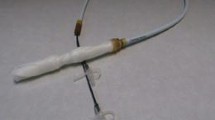Abstract
Background
An intragastric balloon is a non-surgical device enhancing a sensation of early satiety and reducing food intake. The aim of this study is to analyze the results in terms of weight loss and patient satisfaction undergoing intragastric balloon implantation.
Methods
Air-filled and water-filled devices were used. All patients were participated in strict follow-up programs. Weight, body mass index (BMI), total body weight loss (TWL), percentage of excess weight loss (EWL), and satisfaction degree were taken into account.
Results
Eighty-one patients completed a 6-month period with a device in place; 72 of them were then contacted for a follow-up at 12.3 ± 2.4 months post-removal. During treatment period, in 76 cases (93.8 %), a statistically significant reduction in weight was observed. A statistically meaningful linear correlation between a 3-month EWL (or TWL) and a 6-month EWL (or TWL) was found. At the end of endoscopic treatment, a significant link between baseline BMI and EWL >20 % was found. Sixty-three percent of the patients were not satisfied with the procedure, did not deem useful to change their diet, and refused to perform it again.
Conclusions
In our study, at device removal and 1 year thereafter, a statistically significant reduction in weight was observed. Most of the patients were found to have a weight loss more than the cut-off of 20 %. The weight reached at the third month appears to be predictive of the effectiveness of endoscopic treatment. Data showed an overall dissatisfaction with procedure.




Similar content being viewed by others
References
WHO. Obesity: preventing and managing the global epidemic, Report of a WHO consultation on obesity. Geneva: WHO; 1998.
Allison DB, Fontaine KR, Manson JE, et al. Annual deaths attributable to obesity in the United States. J Am Med Assoc. 1999;282:1530–8.
Health benefits of weight loss (2005). In: www.maso.org.my/spom/chap4.pdf
Palmisano S, Silvestri M, Giuricin M. et al. Preoperative predictive factors of successful weight loss and glycaemic control 1 year after gastric bypass for morbid obesity. Obes Surg. 2015
Nieben OG, Harboe H. Intragastric balloons as an artificial bezoar for treatment of obesity. Lancet. 1982;1(8265):198–9.
Geliebter A, Westreich S, Gage D, et al. Intragastric balloon reduces food intake and body weight in rats. Am J Physiol. 1986;251(4 Pt 2):R794–7.
Al-Momen A, El-Mogy I. Intragastric balloon for obesity: a retrospective evaluation of tolerance and efficacy. Obes Surg. 2005;15(1):101–5.
Totté E, Hendrickx L, Pauwels M, et al. Weight reduction by means of intragastric device: experience with the Bioenterics intragastric balloon. Obes Surg. 2001;11(4):519–23.
Sallet JA, Marchesini JB, Paiva DS, et al. Brazilian multicenter study of the intragastric balloon. Obes Surg. 2004;14(7):991–8.
Kotzampassi K, Grosomanidis V, Papakostas P, et al. 500 intragastric balloons: what happens 5 years thereafter? Obes Surg. 2012;22(6):896–903.
Crea N, Pata G, Della Casa D, et al. Improvement of metabolic syndrome following intragastric balloon: 1 year follow-up analysis. Obes Surg. 2009;19:1084–8.
Imaz I, Martínez-Cervell C, García-Alvarez EE, et al. Safety and effectiveness of the intragastric balloon for obesity. A meta-analysis. Obes Surg. 2008;18:841–6.
Mathus-Vliegen EM, Tytgat GN. Intragastric balloon for treatment resistant obesity: safety, tolerance, and efficacy of 1-year balloon treatment followed by a 1-year balloon-free follow-up. Gastrointest Endosc. 2005;61:19–27.
Dumonceau JM. Evidence-based review of the Bioenterics intragastric balloon for weight loss. Obes Surg. 2008;18:1611–17.
Tai C-M, Lin H-Y, Yen Y-C, et al. Effectiveness of intragastric balloon treatment for obese patients: one-year follow-up after balloon removal. Obes Surg. 2013;23:2068–74.
Dogan UB, Gumurdulu Y, Akin MS, et al. Five percent weight lost in the first month of intragastric balloon treatment may be a predictor for long-term weight maintenance. Obes Surg. 2013;23(7):892–6.
Ganesh R, Rao AD, Baladas HG, et al. The Bioenteric Intragastric Balloon (BIB) as a treatment for obesity: poor results in Asian patients. Singapore Med J. 2007;48:227–31.
Ohta M, Kitano S, Kai S, et al. Initial Japanese experience with intragastric balloon placement. Obes Surg. 2009;19(6):791–5.
Giuricin M, Nagliati C, Palmisano S, et al. Short- and long-term efficacy of intragastric air-filled balloon (Heliosphere® BAG) among obese patients. Obes Surg. 2012;22(11):1686–9.
Oria HE, Moorehead MK. Bariatric analysis and reporting outcome system (BAROS). Obes Surg. 1998;8(5):487–99.
Rutten SJ, de Goederen-van der Meij S, Pierik RG, et al. Changes in quality of life after balloon treatment followed by gastric banding in severely obese patients—the use of two different quality of life questionnaires. Obes Surg. 2009;19:1124–31.
Mui WL, Ng EK, Tsung BY, et al. Impact on obesity-related illnesses and quality of life following intragastric balloon. Obes Surg. 2010;20(8):1128–32.
Dastis NS, François E, Deviere J, et al. Intragastric balloon for weight loss: results in 100 individuals followed for at least 2.5 years. Endoscopy. 2009;41(7):575–80.
Acknowledgments
We would like to acknowledge Dr. Cristina Boscaino for translating this article.
Author information
Authors and Affiliations
Corresponding author
Ethics declarations
All procedures performed in studies involving human participants were in accordance with the ethical standards of the institutional and/or national research committee and with the 1964 Helsinki Declaration and its later amendments or comparable ethical standards.
Informed consent was obtained from all individual participants included in the study.
Conflict of Interest
The authors declare that they have no competing interests.
Rights and permissions
About this article
Cite this article
Palmisano, S., Silvestri, M., Melchioretto, B. et al. Intragastric Balloon Device: Weight Loss and Satisfaction Degree. OBES SURG 26, 2131–2137 (2016). https://doi.org/10.1007/s11695-016-2069-4
Published:
Issue Date:
DOI: https://doi.org/10.1007/s11695-016-2069-4




